#ancient buddhism
Explore tagged Tumblr posts
Text
古代グローバル経済世界
昨年の記事。 帝政ローマ時代に属領であった古代エジプト遺跡から、仏像が出土; https://karapaia.com/archives/52322638.html
最初「えっ!?」となった。 確かに、落ち着いてヘレニズム文化のことを想起すれば、ありえる話。
だが、問題はそこではない。
紀元後1世紀ということは、イエス・キリストが存命中だった時期。 つまりイエス自身が仏教徒と出会った可能性が、無きにもあらず。 あるいは古代キリスト教徒が仏教徒と出会った可能性も、あろう。 キリシタンと仏徒とで、お互い影響を与えあったやもしれぬ。
記事にもある通り古代世界とは、私たちが想像していた以上にグローバル経済社会だったのだ。 異文化異民族異教徒たちが行き交い、交易し、情報や芸術や概念すらをもやり取りしていたのだ。
「ミリンダ王の問い」という仏典がある。 ギリシャの北、小国マケドニアから王アレクサンドロスが台頭し、当時世界最大の超大国であり世界帝国ですらあったアケメネス朝ペルシャへ遠征、その頂点に君臨せ��君主ダレイオス三世を打倒、そのまま東征しインダス河畔にまで版図を広げた、そのあとのこと。
そこにおびただしい数のギリシャ人が入植。かくして、数々のギリシャ人国家が古代インド世界に誕生するという、今では想像もつかない事態に。 彼の地の人々はギリシャからインドに至る欧亜の諸言語をあやつり、時には野蛮人を意味するギリシャ語「バルバロイ」を逆にギリシャ人に対して使うという、中華思想ぶり笑。 それくらい文化が開花した欧亜ハイブリッド国家群となった。
その中の一国、アフガンからパキスタンを経てインド北西部にまで勢力を広げていたのは、その名もグレコ・バクトリア王国。
その王、ミリンダ。彼もまた多言語を自在にあやつり、知識人であったところ、その領地にて一人の仏僧と出会った。 ミリンダ王はギリシャ系らしく、合理的論理的な議論の数々を仏僧にぶつけるも、僧はことごとく仏教ロジックでもって明解に回答。 すっかり感服したミリンダ王は、最後には仏教徒になったという。 そしてこの史実と問答とが記録されたのが、仏典の一つ「ミリンダ王の問い」であった。
ギリシャ人が仏教に帰依するという、愉快なる古代事件。
異文化異民族異教徒たちが入り乱れ香り高き文化の華咲き誇る、古代グローバル経済世界。
人類は、常に好奇心でもって未知の土地へと向かう。 あの山の向こうには何があるのだろう? あの島には何があるのだろう? そうやって人類は好奇心に駆動されるがままに拡散し、ついには宇宙の挑戦を受けて立った。 そして異なる人々と出会い、さまざまな軋轢に苦しみながらも、それでも尚、異なる人々こそはみずからの限界を突破してくれる鍵なのだと知って、多様性に賭けた。弱肉強食に任せない福祉とは、多様性を担保するために人類が編み出した生存の知恵と工夫である。
時には戦もあった古代世界。未だ文明の幼少期と思われていた紀元前後の古代世界において、それでもすでに古代なりのグローバル世界が、多様性を誇る世界経済空間が、ごくごく自然に当たり前に生まれていたのであった。
そのことを思えば、昨今の国際情勢のなんとみみっちぃことかと。 お前ら一体なにしとんねんと、独裁者どもに申し上げたい。
#diversity#global#global economy#ancient global economy#ancient rome#ancient egypt#ancient india#ancient buddhism#religions#ukraine#palestina#israel#gaza#free
1 note
·
View note
Text










The Cryptic Motif of “Three Hares with Conjoined Ears”
On the Heavenly Palace decorative patterns found in the Mogao Caves at Dunhuang from the late Northern dynasties are images with cryptic patterns, including Buddha's head, the Taotie beast, deer, animals copulating, three hares with conjoined ears, and also writings. This type of decorative pattern is cryptic and difficult to understand and may be closely related to the history of the popular Eastern iconology and divination philosophy from the Han and Wei dynasties and Emperor Wu of Northern Zhou's suppression of Buddhism. They are important references for studying the related history of this period.
#china#motif#three hares with conjoined ears#silk road#culture influenced by buddhism from ancient india#art#reference
1K notes
·
View notes
Text

#consciousness#light#energy#magic#alchemy#ascension#ancient#quotes#godhood#age of aquarius#golden age#kundalini#enlightenment#meditation#buddha#buddhism
88 notes
·
View notes
Text








Laughing Buddhas From The Flying Peak
Vivid figures of Buddhas and Bodhisattvas carved in the rock on the Flying Peak, Feilai Feng (飛來峰石窟) in the Wulin Mountains (武林山), Zhejiang.
Their cheerfulness in no way contradicts the solemn and misty ambiance of the Feilai Feng Grottoes themselves. Limestone peak looks alien in the surrounding mountain landscape, so there is an opinion that it flew here by the power of Buddhist wonder-workers. The main cave is dedicated to the Bodhisattva Guanyin. Due to a natural crack in the ceiling, a radiant halo surrounds the statue.
The carvings are from different periods and date from the Tang to the Ming.
Photo: ©俊灵-
#ancient china#chinese culture#chinese art#buddha#buddhist#buddhist deities#buddhism#buddhist temple#guanyin#chinese mythology#观音#religious art#rock carvings#buddha statue#bodhisattva#chinese folk religion#tang dynasty#song dynasty#yuan dynasty#ming dynasty
275 notes
·
View notes
Text

Temple of Vishvakarma (cave 10, VII c. A.C.) - Ellora, 2013
#original photographers#photographers on tumblr#travel#india#ancient architecture#indian architecture#architecture#buddhism#cave#buddhist temple
76 notes
·
View notes
Text
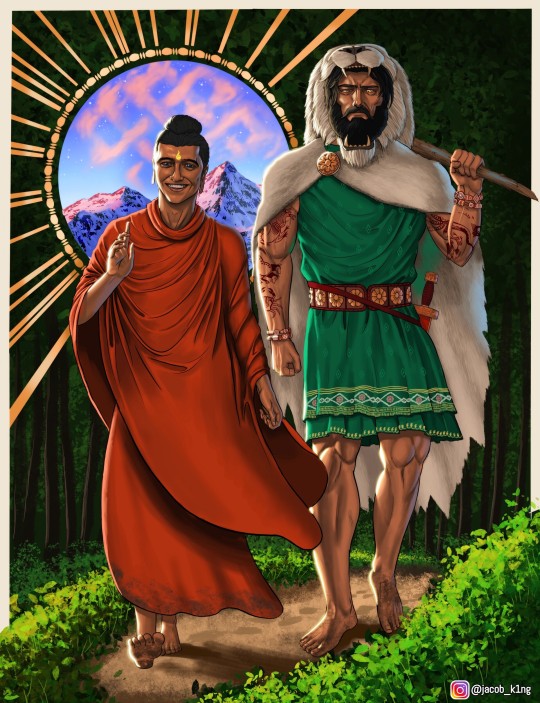
Heracles and the Buddha
This is based on the fascinating fusion of cultures after Alexander the Great invaded India, otherwise known as Indo-Greek or Greco-Buddhism. In Gandharan sculpture, Heracles is depicted alongside the Buddha as Vajrapani, the Buddha's protector. The pairing of two figures so iconic in their mythologies seemed perfect material for art. The Buddha would help Heracles with anger management, while Heracles would help with clobbering evildoers. Business as usual.
#heracles#hercules#herakles#buddha#buddhism#zen#dharma#ancient greece#ancient india#indo-greek#vajrapani#greek mythology#greek myth art#classical mythology#the buddha#tagamemnon#art#illustration#mythology#buddhist#alexander the great#ancient history
380 notes
·
View notes
Text
Numerology: The number 9
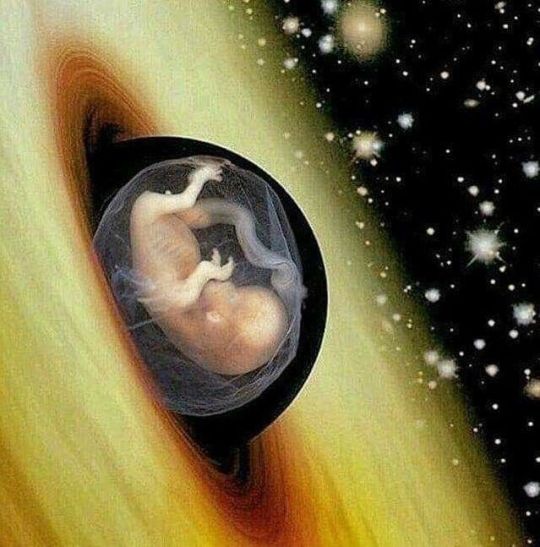
9 18 27 36 45 54 63 72 81 90 99
What does the number 9 signify? 9 means completion, but not a final ending.
In astrology: the number 9 is associated with the planet Mars, which is said to govern ambition, energy, and action. People born under the sign of Mars, which is associated with the number 9, are said to be confident, independent, and adventurous. The ninth sign of the zodiac, Sagittarius, is known for its adventurous and expansive spirit, which reflects the qualities of the number 9. Additionally, the number 9 is linked to the concept of karma, which refers to the idea that our actions have consequences that come back to us. This is because 9 is the result of adding up all the single-digit numbers before it (1+2+3+4+5+6+7+8=36, and 3+6=9), suggesting that we reap what we sow. Overall, the number 9 is significant and powerful in astrology, representing completion, growth, and the consequences of our actions. Moreover, in Vedic astrology, the nine planets or Grahas are believed to have a significant influence on human destiny and are associated with different qualities and energies. These planets include the Sun, Moon, Mercury, Venus, Mars, Jupiter, Saturn, Rahu, and Ketu. The Sun and Moon are considered the most important planets, as they are responsible for life on Earth and are associated with the soul and mind, respectively. The number 9 is associated with the planet Guru or Jupiter, which is considered the most benefic planet in the horoscope. Guru is associated with wisdom, knowledge, and good fortune. People who are born on the 9th, 18th, or 27th of any month are said to be influenced by the planet Guru and are considered to be blessed with good luck and prosperity.
In astronomy: the number 9 is perhaps most famously associated with the nine planets in our solar system. the number 9 has significance in the relationship between the Sun, Moon, and Earth. It is said that the Sun completes a cycle of 360 degrees in the sky in one year, which is divided into 12 zodiac signs, with each sign taking up 30 degrees. The Moon, on the other hand, takes about 29.5 days to complete its cycle around the Earth, and during this time, it passes through all 12 zodiac signs. Interestingly, the total number of days in a solar year (365.24) multiplied by the number of lunar months in a year (12.37) equals 4536.24, which can be reduced to 9. This is known as the lunar-solar cycle, and it is believed to be a powerful symbol of completion and transformation.
In mythology: the number 9 is often associated with spiritual growth and knowledge. For example, in Norse mythology, Odin hung from the world tree Yggdrasil for nine days and nine nights to gain wisdom and knowledge. In Greek mythology, nine muses inspired creativity and art, while in Egyptian mythology, nine gods presided over the underworld.
In mathematics: the number 9 has some unique properties as well. It is the highest single-digit number, and any number multiplied by 9 will always result in a number whose digits add up to 9. Additionally, the number 9 is the sum of the first three square numbers (1² + 2² + 3² = 9) and the sum of the first three cube numbers (1³ + 2³ + 3³ = 36). This property of the number 9 is known as the "digital root" and is used in various mathematical and divinatory practices.
In physics: the number 9 appears in the fundamental equations that describe the behavior of the universe, such as the nine-dimensional equations of string theory. In mathematics, the number 9 is used in a variety of numerical systems, including the base-9 system used by the ancient Maya.
In science: the significance of number 9 in science is reflected in its frequent appearance in various scientific phenomena. For instance, the periodic table has nine fundamental types of atoms, known as lanthanides. The human body is made up of nine major organ systems, including the cardiovascular, nervous, and respiratory systems. The electromagnetic spectrum has nine main categories of waves, ranging from radio waves to gamma rays. Sun and Earth: The diameter of the Sun is supposed to be 108 times the diameter of the Earth. The distance from the Sun to the Earth is 108 times the diameter of the Sun. It looks very dramatic and mysterious yet if true its indeed happy mystery. Moon and Earth: The average distance of the Moon from the Earth is 108 times the diameter of the Moon. Furthermore, there are nine planets in our solar system (including Pluto, which is now considered a dwarf planet), and the number 9 also appears in the fundamental equations that describe the behavior of the universe, such as the nine-dimensional equations of string theory. The number 9 also appears in the concept of tides, which are caused by the gravitational pull of the moon and sun on the Earth's oceans. Tides follow a roughly 12-hour cycle, with high and low tides occurring twice a day, resulting in a total of around 9 tides per day.
In ancient Egypt: the number 9 was associated with the nine gods who ruled over the underworld.
In music: the significance of the number 9 in music is rooted in its harmonic properties. The ninth note of a scale, known as the subtonic, is a crucial note for creating tension and leading to the tonic note. This creates a sense of resolution and closure in musical phrases. Additionally, the number 9 appears in musical time signatures such as 9/8, which adds a unique and complex rhythmic texture to the music. The number 9 also plays a symbolic role in music, as seen in The Beatles' "Revolution 9," a groundbreaking experimental track that features various sound effects and spoken word samples. Overall, the number 9 adds depth and complexity to the music, both in its harmonic properties and its symbolic significance.
Nine Muses: In Greek mythology, the Nine Muses were the goddesses of inspiration in the arts and sciences, such as music, poetry, and astronomy. They were said to be the daughters of Zeus and Mnemosyne and were believed to provide inspiration and guidance to human beings.
Nine Worthies: The Nine Worthies were a group of historical and legendary figures from different cultures who were seen as exemplars of chivalry and virtue. They were divided into three categories of three: pagan, Jewish, and Christian. The pagan worthies were Hector, Alexander the Great, and Julius Caesar; the Jewish worthies were Joshua, David, and Judas Maccabeus; and the Christian worthies were King Arthur, Charlemagne, and Godfrey of Bouillon.
Ennead: In ancient Egyptian mythology, the Ennead was a group of nine gods and goddesses who were worshipped in the city of Heliopolis. The Ennead included the god Atum, who was believed to have created the world, and his children Shu and Tefnut, who represented air and moisture, respectively.
Nine Emperor Gods Festival: The Nine Emperor Gods Festival is a Taoist festival celebrated in Southeast Asia, particularly in Thailand, Malaysia, and Singapore. The festival is held in the ninth lunar month and is dedicated to the worship of the Nine Emperor Gods, who are believed to bring good luck and prosperity.
The 9th letter of the alphabet is "I", which is also the Roman numeral for the number 1. This means that "IX" is 9 in Roman numerals, which is why you sometimes see clocks or watches with "IX" instead of "IX" to represent 9.
Islam: Quran says that each and everything of this universe is counted and surrounded by numeric. The 9th chapter of the Qur'an At-Tawbah 'the Repentance', and is one of the last Medinan surahs. The number 9 is the day of Hajj. The Messenger Mohammad participated in 9 of the conquests. And nine Qur’anic verses speak about the prophet Moses. The Arabic letters of the opening in the Qur’an add up to 786=9, 786 is an Arabic numeric value that denotes“Bismillah al-Rahman al-Rahim” the opening phrase of the Holy Quran. It translates as “In the name of Allah, the Most Merciful, the Most Beneficent“. 786 is basically driven from the series of Arabic Numerology called “Abjad“. In Muslim tradition it is known to be the symbolic representation of Allah. But no Islamic scholar has so far been able to explain the origin of this number. In fact, it is not mentioned in the Quran. Ramadan: a time of fasting and spiritual reflection for Muslims, is the ninth month of the Islamic calendar.
Biblical Symbolism: The number nine is found 49 times in Scripture. Its biblical symbolism is tied mainly to the concepts of finality, divine completeness, and judgment. It typically surfaces during pivotal moments of transformation, culmination, or judgment in the biblical narrative. In the divine order of creation, the Lord chose to create a nine-month gestation period for human beings, indicating a time of completeness before birth. The number nine often marks the end of a divine cycle or period. In the context of the Old Testament, every ninth year represented the end of one cycle and the beginning of a new one. The number 'nine' also weaves a pattern of divine judgment throughout biblical history. For instance, the prophet Hosea, inspired by God, declared that Ephraim's destruction would come to the city in the 'ninth' year. In another instance, the ninth hour was marked for Christ's death, symbolizing the largest divine judgement humanity has ever witnessed. Ezekiel 24:1-2 noted the siege of Jerusalem commenced on the 'ninth' day of the tenth month. Adding to its significance, the city's destruction commenced on the 'ninth' day of the fourth month. Nine Attributes of God: The Lord is patient, The Lord is Merciful, The Lord is Gracious, The Lord is Abundant in Goodness, The Lord is Abundant in Truth, The Lord is Loving, The Lord is Forgiving, The Lord is a God that Judges, The Lord is Just. In Christianity, there are nine fruits of the Holy Spirit, including love, joy, peace, patience, kindness, goodness, faithfulness, gentleness, and self-control.
The number 9 is revered in Hinduism and considered a complete, perfected and divine number because it represents the end of a cycle in the decimal system, which originated from the Indian subcontinent as early as 3000 BC. The number 9 is considered a lucky number in many cultures, including in China and Japan, where it is associated with longevity and good fortune. In numerology, the number 9 is associated with spiritual growth, selflessness, and humanitarianism.
In Hinduism: The number 9 has played a significant role in Indian history, culture, and mythology. In Hinduism, there are nine planets, nine forms of Devi, and nine forms of Lord Vishnu. The number 9 is also associated with the Navratnas, which are the nine precious gemstones. According to Hindu mythology, there are nine avatars of Lord Vishnu, including Matsya, Kurma, Varaha, Narasimha, Vamana, Parashurama, Rama, Krishna, and Kalki. These avatars are believed to have appeared on Earth in different forms and at different times to restore balance and order. The number 9 is also significant in other Indian religions and traditions. In Buddhism: there are nine stages of consciousness. Some Buddhists carve have 108 small Buddhas on a walnut for good luck. Other Buddhists, like in Tibet and in Bhutan, they ring a bell 108 times to celebrate a new year. They believed it as corresponding to 108 virtues to cultivate and 108 defilements to avoid. Chinese Buddhists and in the Taoists 108 bead mala (called su-chu), and has three dividing beads, so the mala is divided into three parts of 36 each. Chinese astrology also believed that there are 108 sacred stars. while in Jainism, there are nine tattvas or principles of reality. The number 9 is also associated with the nine chakras, or energy centers, in the body. Nine Gems: The Navratnas, or nine gems, are considered to be powerful and auspicious in Indian culture. These include diamond, pearl, ruby, emerald, yellow sapphire, blue sapphire, hessonite, cat The significance of the number 9 can also be seen in Indian architecture and art. For instance, the famous Hindu temple, Brihadeeswarar Temple, located in Thanjavur, Tamil Nadu, was built in the 11th century and is known for its unique architecture that features nine stories, representing the nine planets in Hindu mythology. The temple also has nine entrances, nine corridors, and nine sacred tanks, emphasizing the importance of the number 9 in Hindu culture. Another example of the significance of the number 9 in Indian art is the Navarasas or the nine emotions, which are depicted in various forms of art, including dance, music, and theater. The nine emotions are Shringara (love), Hasya (laughter), Karuna (compassion), Raudra (anger), Veera (courage), Bhayanaka (fear), Bibhatsa (disgust), Adbhuta (wonder), and Shanta (peace). These emotions are believed to be the essence of human experience and are often portrayed in Indian art and literature. Furthermore, the number 9 is also believed to have healing properties in Ayurveda, the ancient Indian system of medicine. According to Ayurveda, the human body is composed of nine elements or dhatus, which are Rasa (plasma), Rakta (blood), Mamsa (muscle), Meda (fat), Asthi (bone), Majja (marrow), Shukra (semen), Artava (ovary), and Purisha (feces). These elements are believed to be interconnected and affect each other, and any imbalance in these elements can lead to illness. Ayurvedic remedies often involve balancing these elements to promote health and well-being.
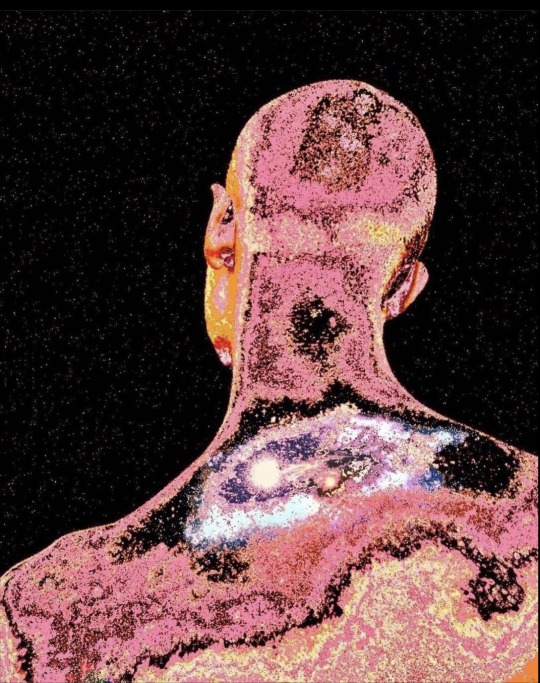
#numerology#vedic astrology#astrology#astronomy#science#greek mythology#hinduism#islam#christianity#bible#holy quran#literature#research#music#ancient egypt#physics#zodiac#zodic signs#astro notes#tarot#chakras#karma#buddhism#jewish#Destiny number#Destiny 9#9 life path#life path#life path 9
59 notes
·
View notes
Text
fools are getting confused between Shakyas and Shakas and they're trying to teach our own history to us. He was called Shakya muni. Not Saka muni.

50 notes
·
View notes
Text
youtube
The Ancient Greeks Who Converted to Buddhism
from ReligionForBreakfast
36 notes
·
View notes
Text
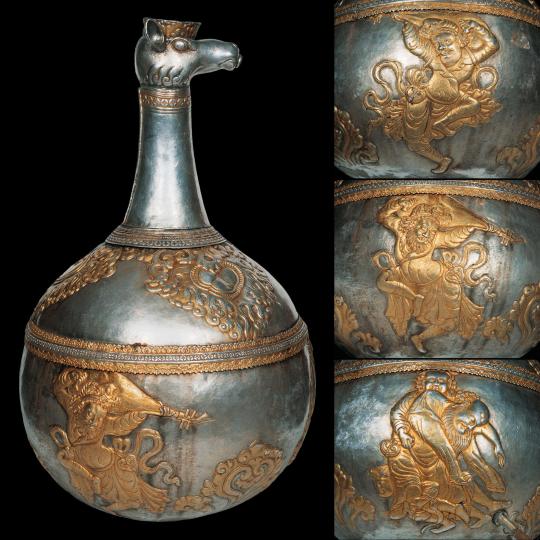

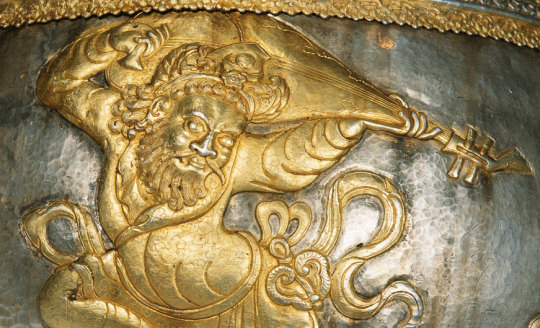
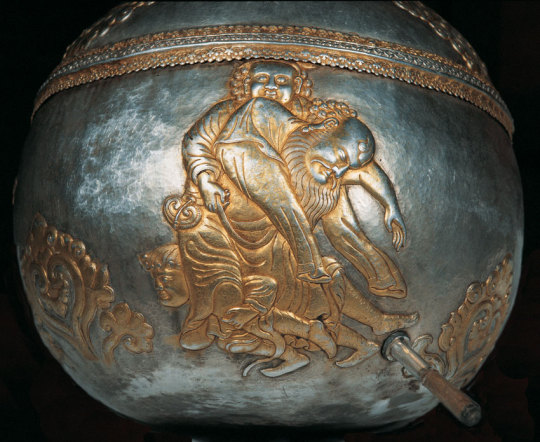

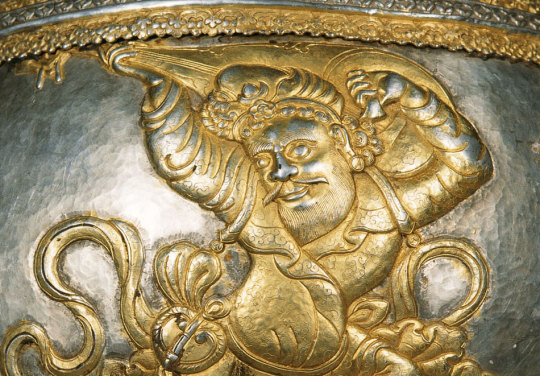
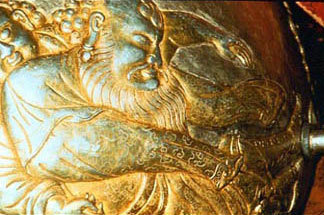

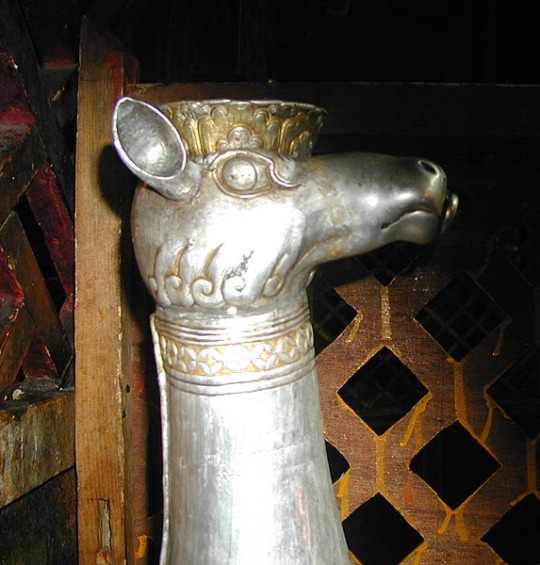
The Jug of Jokhang 7th-8th C. CE. Central Asians (probably Sogdians) depicted on Tibetan art.
"At present, a silver jug stands in a wooden frame in one of the chapels of the Lhasa Jokhang, traditionally regarded as the oldest temple in Tibet (see figs 1-7). This jug is approximately 80 cm in height. It was hammered from silver sheets, cut and assembled in four parts, two hemi- spherical sections joined at the diameter of the circle, a long thin neck, surmounted by an animal head with round mouth from which liquid can be poured. It weighs some 35 kg when full of liquid, and monks fill it daily with offerings of chang, Tibetan barley beer. The gilded designs on the upper bowl of the jug are raised scrolling in heart shaped medallions, while on the lower bowl, there are three scenes representing Central Asian people, two lively solo dancers and three men in drunken revelry". (taken from AsianArt by Amy Heller).
Dance was a skill that Sogdians learned at a young age, and continued to use as they got older:
"The Iranian from Tashkent [Chach] appears young He dances to the music before the wine goblet, as rapid as a bird He wears a cloth cap of foreign make, empty and pointed at the top His Iranian robe of fine felt his tight sleeves" (Shafer 1963, 55 in Lerner 2001, 254)
#tibetan art#sogdiana#ancient history#history#art#art history#art detail#buddhism#temple#beer#iranian#dance history
347 notes
·
View notes
Text
Early Buddhist artists seem to have been reluctant to depict the Buddha himself. So how did they do it? One of the earliest, and simplest, ways that artists represented the Buddha was through the marks he left behind on the earth — his footprints.
These footprints were often filled with symbols of the Buddha like dharma wheels and swastikas, both of which refer to the cycle of birth and rebirth.
Some footprints, like these from Amaravati in the second century BCE, were literally filled with symbolism:

{Buy me a coffee} {WHF} {Medium} {Substack}
More striking footprints, along with other fascinating Buddhist art here:
159 notes
·
View notes
Text
Green Tara—Bangladesh or West Bengal (India), early 12th century

This is from a manuscript of Ashtasahasrika Prajnaparamita (Perfection of Wisdom). According to the Met, "Enshrined image of Green Tara with pendant leg and displaying a blue lotus, with two female attendants, one holding a vajra; the other, Mahakali, holding a flaying knife and skullcup (kapala)."
20 notes
·
View notes
Text
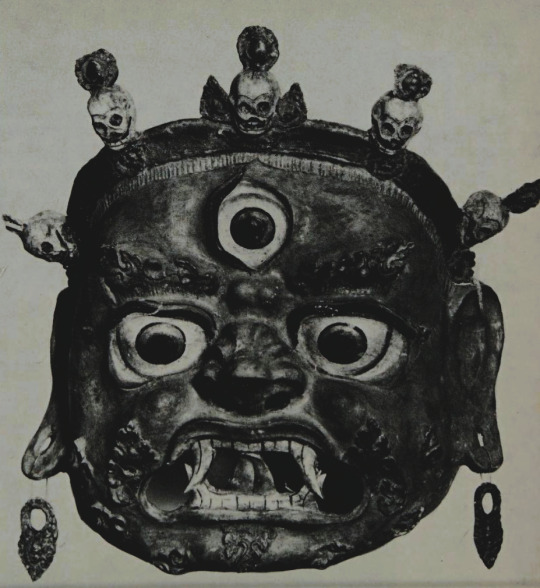
#tibetan buddhism#buddhist art#art#art history#mask#mahakala#buddhist#ancient#history#ancient civilizations#black and white#b&w picture#b&w#mythology#asia#asian#void#image#archeology#buddhist science#science#folk magic#folklore#magick#witchcraft
584 notes
·
View notes
Text

Mingun Pahtodawgyi - Myanmar
#mingun Pahtodawgyi#pagoda#myanmar#ancient ruins#light#consciousness#technology#energy#magic#ascension#archaeology#archeology#architecture#engineering#alchemy#ancient#esoteric#kundalini#spiritual awakening#spirit#buddha#buddhism
74 notes
·
View notes
Text

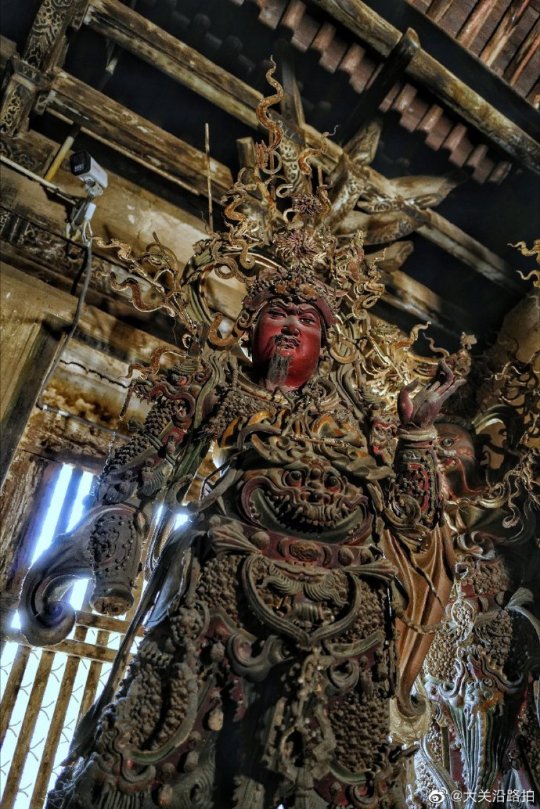
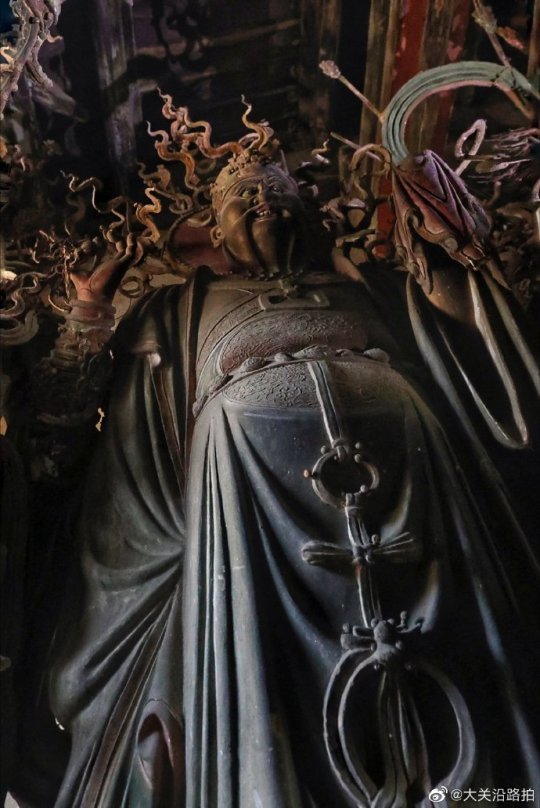
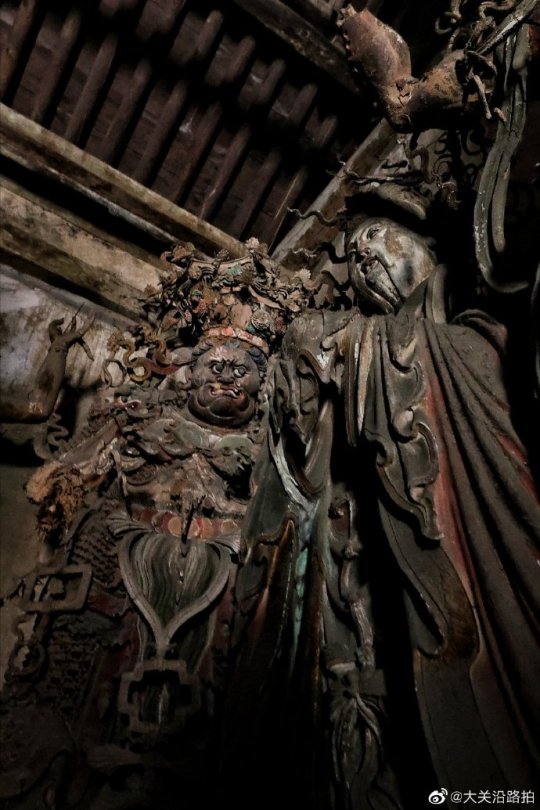
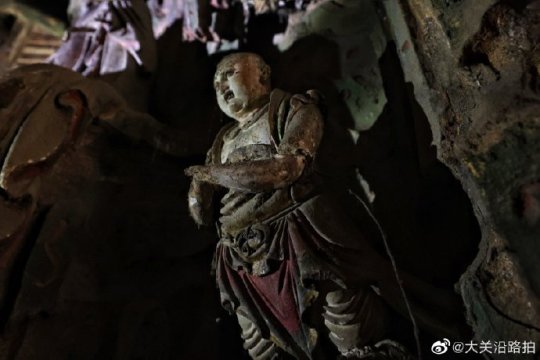


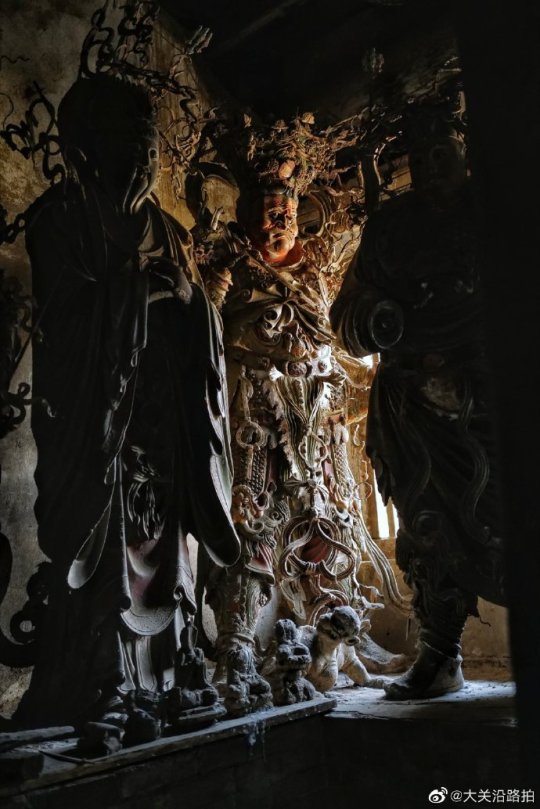
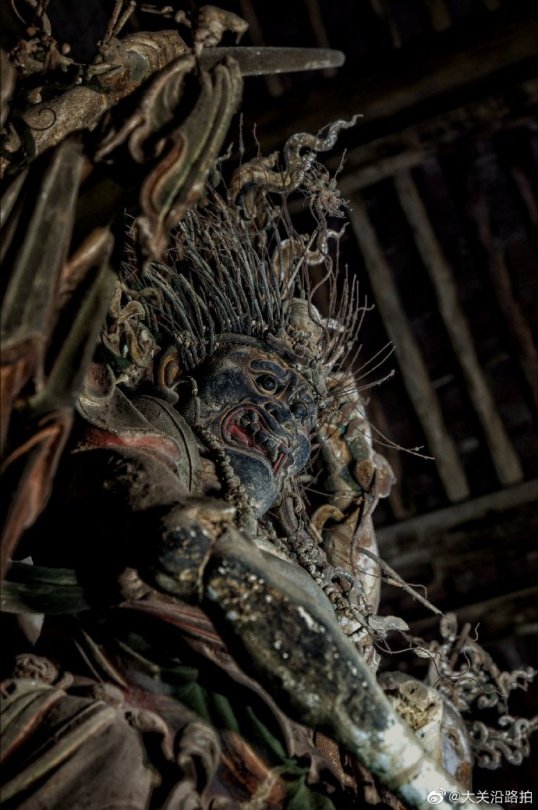
Extreme Baroque: Iron Temple On The Rice Mountain
Grotesque images from the Buddhist Iron Temple (鐵佛寺).
Located on the Rice Mountain (米山), Mixi (米西村) village, Jincheng, Shanxi, the temple is of an unknown construction date. The earliest record on the stone pillar in the main hall dates back to the seventh year of the Dading (大定) period of the Yuan or Jin dynasties. There is evidence that the temple was reconstructed in the third year of Wanli (1575). However, in the county annals, it is mentioned no earlier than the Qing dynasty.
These astonishing, presumably Ming statues owe their creation to the proximity of an iron ore. Iron frames made it possible to give the clay figures intricate poses and frilly decor.
Photo: ©大关沿路拍
#ancient china#chinese culture#chinese mythology#chinese art#chinese architecture#yuan dynasty#jin dynasty#chinese temple#statues#sculptures#scultpure#buddhist temple#buddhist#buddhist deities#religious art#buddhism#ming dynasty#qing dynasty#statuary#religious imagery
211 notes
·
View notes
Text

Snake - Htat Eian Cave, 2017
#original photographers#photographers on tumblr#travel#myanmar#cave#ancient art#oriental art#carved wood#snake#religion#buddhism
69 notes
·
View notes